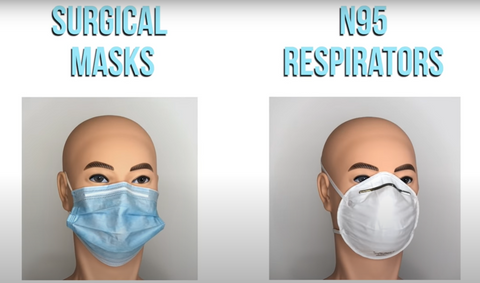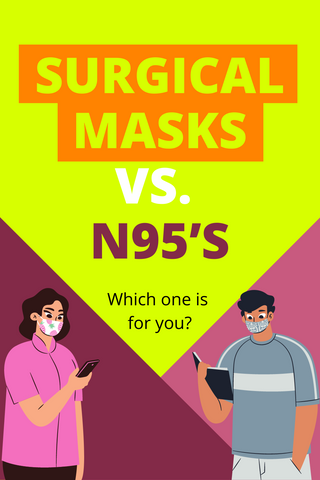With all the information out there on face masks right now, it can be challenging to know which face mask to use and when. Especially when it comes to choosing between surgical masks and N95's. In this blog post, I wanted to go over a few important factors that make these two items of PPE unique so that you can make the best choice for your situation.
Surgical Masks Vs. N95s
#1 The Basics
When it comes to understanding the difference between a surgical mask and an N95, one of the first things you're going to notice is that they look very different.
To start with, a surgical mask is a single-use flat piece of polypropylene with pleats sewn in to fit the area around the nose and the jawline. It also has a small bendable nose piece to help fit around the nose.

An N95 respirator is a non-woven polypropylene fiber mask with a small nose piece to mold it to fit around the nose. It's designed to provide a seal and fit closely to the face. Some N95s are molded, while others are folded, and some are vented.
My favorite N95: https://allysafety.link/N95
Use code ALLY10 for 10% off.
The surgical mask is intended to control aerosols and droplets at the source, meaning they prevent most of your aerosols and droplets from escaping and potentially infecting others with the coronavirus. They provide a modest filter for the wearer preventing other people's respiratory droplets and aerosols from being inhaled. These are most effective if everyone uses them to prevent the spread of their own respiratory droplets and aerosols.
On the other hand, the N95 respirator was designed to be a filter to protect the wearer. It was originally built as a single-use respirator that works by filtering out 95% of particulate including aerosols and droplets. In addition to that, it can also provide source control.
Knowing that you may wonder why aren't we all wearing respirators?
There are a few important reasons why.
#2 Face Seal and Fit
You'll notice the surgical mask is loose-fitting, it doesn't form a seal to the face and particles can enter through gaps where the fit is not secure. Despite the loose fit, this actually has been proven to provide enough protection from covid19 when others wear them and practice social distancing. Due to the loose fit, even those with lung conditions can find it easy to breathe through surgical masks.
The N95 is built to provide a tight fit and mold to the shape of the face, ensuring that particles don't enter through side openings, as long as it's worn correctly. Just in case you're new to respiratory protection, a tight seal can only be obtained if you're clean-shaven.
Breathing through a filter, which what an N95 is, makes breathing more difficult, for many, they won't be comfortable for daily use and can make breathing challenging.

#3 Fit Testing Requirements
If you're planning on wearing surgical masks in the workplace, there are no fit testing requirements through OSHA.
But if you're going to wear an N95 in the workplace, they have to be fit tested to make sure a good seal is achieved and also to make sure wearers are healthy enough to manage the extra effort it takes to breathe through a respirator.
#4 Leakage
Leakage occurs around the edge of the mask when the user inhales or exhales. Although the mask does make it more difficult for large droplets to escape and also limits how far they can travel. When properly fitted and worn, minimal leakage occurs with an N95 respirator unless you're wearing an N95 with an exhalation valve. Which you don't want to do during the covid-19 pandemic because N95's with a valve allow your exhalations to escape freely, protecting you but no one else.

#5 Testing and Approval
For a surgical mask, testing and approval are provided by the US Food and Drug Administration FDA, along with ASTM Consensus Standards.
The FDA and NIOSH regulate N95 respirators that are intended for use in health care settings.
#6 Use and Limitation
A surgical mask is intended for minimal use and needs to be discarded after each use. This is also the guidance for N95's. An N95 respirator also needs to be discarded if it becomes damaged or deformed and no longer provides a tight seal.
Those are the major differences between surgical masks and N95 respirators. For most of us, studies have shown a surgical mask used in addition to social distancing is enough to help prevent the spread of coronavirus. For those of us who can't socially distance, like healthcare workers, an N95 respirator may be a better option.
In some instances, because it provides a tight seal against respiratory droplets and aerosols, it's best to conduct a hazard assessment to see which one of these is the best option for your workplace. I hope this blog post helped you to clarify the difference between surgical masks and N95 respirators.
Pin It!




1 comment
Joseph Middleton
Hi this link https://allysafety.link/N95 is giving me a error message can you email the correct link
Leave a comment
All comments are moderated before being published.
This site is protected by hCaptcha and the hCaptcha Privacy Policy and Terms of Service apply.